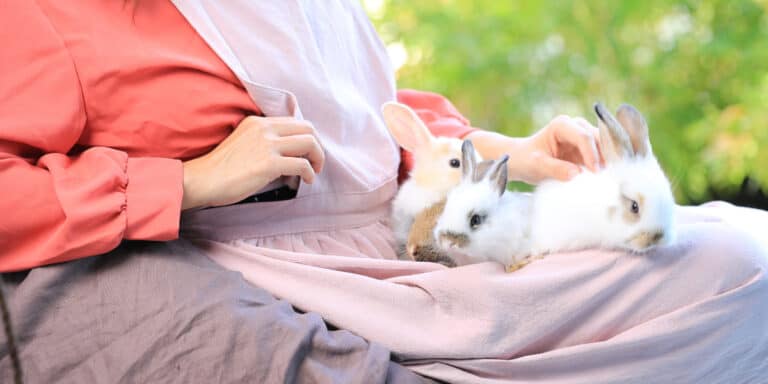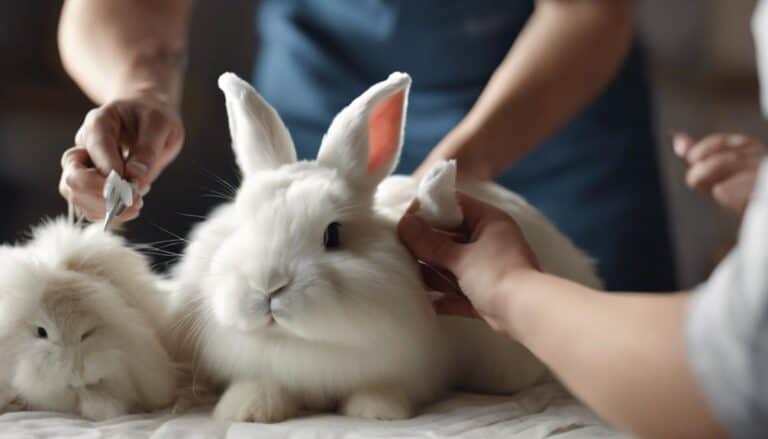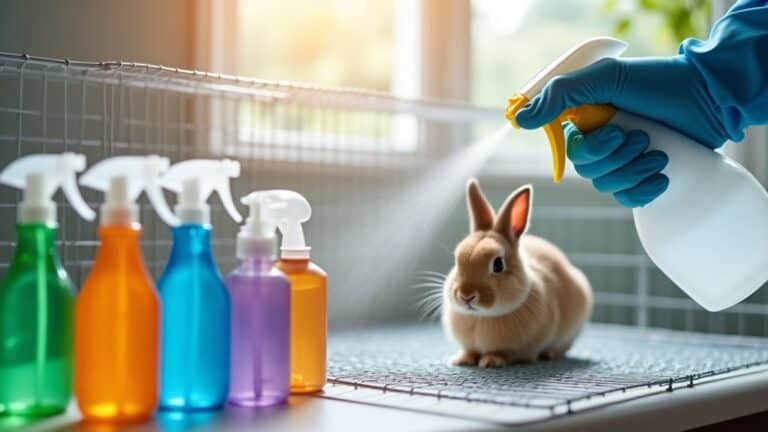When it comes to brushing a bunny's fur, you might worry about causing them discomfort or pulling too hard. However, with the right technique, you can make sure a pleasant grooming experience for your furry companion.
Understanding the proper way to brush your bunny's fur is important for their well-being and happiness. Stay tuned to discover the gentle steps and effective methods that will keep your bunny's coat healthy and shiny.
Contents
- 1 Key Takeaways
- 2 Importance of Proper Bunny Fur Brushing
- 3 Choosing the Right Brush for Bunnies
- 4 Step-by-Step Guide to Brushing Bunny Fur
- 5 Handling Bunny's Dislike for Brushing
- 6 Dealing With Matted Fur in Bunnies
- 7 Special Care for Long-Haired Bunnies
- 8 Frequently Asked Questions
- 9 What Should I Avoid When Brushing My Bunny’s Fur to Ensure I’m Doing It Properly?
- 10 Conclusion
Key Takeaways
- Regular brushing prevents fur ingestion and hairball formation.
- Select soft-bristled brushes to prevent skin irritation.
- Long-haired breeds benefit from slicker brushes to prevent matting.
- Seek professional help for safe and effective grooming procedures.
Importance of Proper Bunny Fur Brushing
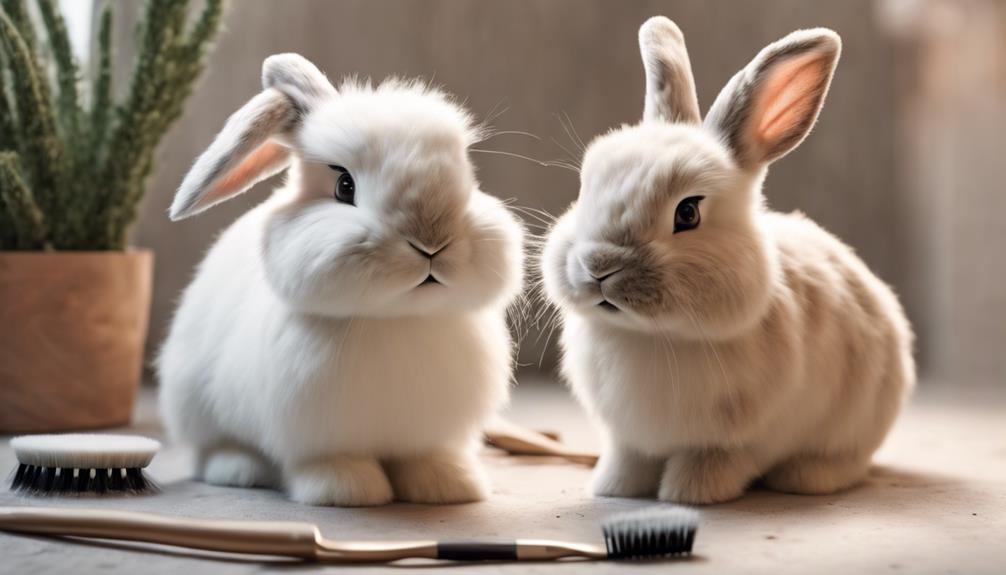
Regularly brushing your bunny's fur is important for preventing fur ingestion, hairball formation, and maintaining your rabbit's comfort and well-being. Grooming your rabbit not only keeps their fur clean and free from mats but also plays a vital role in preserving their skin health. This practice is especially important for long-haired rabbit breeds prone to developing tangled and dirty fur. By incorporating brushing into your rabbit's routine, you can prevent discomfort and potential health issues associated with neglected fur care.
Moreover, proper grooming techniques aren't only beneficial for your rabbit's hygiene but also foster a stronger bond between you and your pet. Engaging in regular brushing sessions provides an opportunity for interaction and bonding, creating a positive experience for both you and your furry companion. Establishing a consistent grooming routine ensures that your rabbit remains comfortable, clean, and healthy, promoting their overall well-being and longevity.
Choosing the Right Brush for Bunnies
When selecting a brush for your bunny, consider using a soft-bristled option to prevent skin irritation. Opt for brushes with fine-toothed combs to effectively remove loose fur and prevent matting. Choose a brush specifically designed for small animals like rabbits to confirm safe and gentle grooming sessions.
Make sure to brush your bunny regularly to maintain a healthy coat and to bond with your pet. Aim for short grooming sessions to prevent stress and discomfort for your bunny. Be gentle and patient while brushing, especially in sensitive areas like the belly and hindquarters.
Brush Types for Bunnies
To make certain the proper grooming of your bunny's fur, selecting the right brush tailored to your bunny's coat type is imperative. Short-haired bunnies benefit from soft bristle brushes for gentle grooming, while long-haired breeds like Angoras require slicker brushes to prevent matting.
Furminator brushes are effective for removing loose fur from double-coated breeds, and rubber brushes work well for surface brushing and massaging sensitive bunny skin. Additionally, fine-toothed combs designed for cats can help eliminate loose hair from rabbit coats.
Choosing the appropriate brush based on your bunny's fur length and texture ensures effective and gentle grooming, keeping your furry friend happy and healthy.
Fur Length Considerations
Have you ever wondered how to choose the right brush for your bunny based on its fur length?
When it comes to grooming rabbits, considering their fur length is important. Long-haired breeds such as Angora and Lionhead rabbits require brushes with long, gentle bristles to reach their undercoat effectively. On the other hand, short-haired rabbits can benefit from brushes with shorter, firmer bristles that efficiently remove loose fur.
Slicker brushes are ideal for eliminating mats in long-haired rabbits, while rubber brushes are gentle for surface brushing. By understanding your rabbit's fur type and selecting the appropriate brush, you can make sure a comfortable grooming experience that effectively maintains their fur health.
Gentle Brushing Techniques
Considering the fur length of your bunny, selecting the right brush is essential for maintaining their coat health and preventing matting.
For rabbits with sensitive skin, opt for a soft-bristled brush to avoid irritation.
Use a slicker brush or fur buster for effective removal of loose fur, and a flea comb or rubber brush for gentle surface brushing.
Harsh tools like scissors should be avoided, and instead, choose grooming tools specifically designed for rabbit care.
Regular brushing with gentle techniques not only helps in preventing matting but also contributes to your bunny's overall well-being.
Step-by-Step Guide to Brushing Bunny Fur
Before brushing your bunny's fur, gently pet them to help them relax and prepare for grooming.
Start by using a soft-bristled brush, brushing your rabbit's fur gently in the direction of growth. Pay close attention to matting areas like behind the ears and under the chin, ensuring you carefully work through any tangles.
While brushing, pluck out any loose fur to prevent hairballs from forming.
Once you've gone over your rabbit's fur with the soft brush, switch to a rubber brush to remove any remaining loose fur and give your bunny a final smooth coat. This step will also help in stimulating natural oils in their skin, promoting a healthy coat.
Handling Bunny's Dislike for Brushing
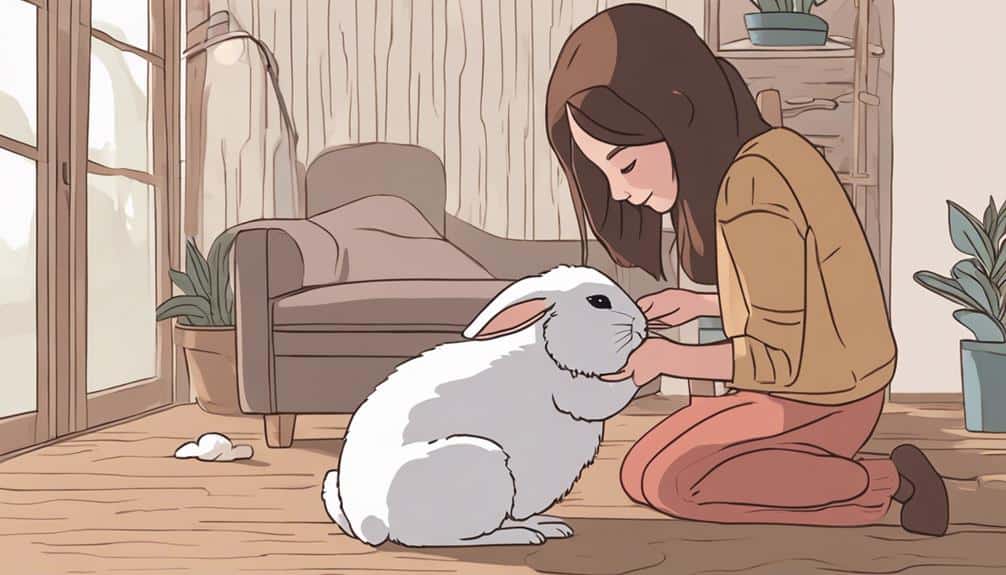
If your bunny dislikes brushing, it's important to address their resistance with a gentle touch and approach.
Introduce grooming tools like flea combs or rubber brushes to minimize discomfort.
Remember to be patient, take breaks as needed, and use consistent positive reinforcement to help your bunny overcome their dislike for grooming.
Tackling Brushing Resistance
To address a bunny's resistance to brushing, start by introducing gentle grooming tools such as rubber brushes or soft bristle brushes. Some rabbits may dislike brushing due to sensitive skin or past negative experiences. Help your bunny associate positive experiences with grooming by offering treats or favorite toys during brushing sessions. This will help create a more pleasant association with the grooming process.
Gradually increase the duration of grooming sessions to build your rabbit's tolerance and comfort with brushing. If your bunny consistently resists despite gentle approaches, seek advice from a rabbit-savvy veterinarian or experienced groomer for additional help and guidance. Remember, patience and positive reinforcement are key when tackling brushing resistance.
Gentle Approach Techniques
Introduce your bunny to gentle brushing techniques by using slow, careful strokes to guarantee them to the grooming process. Start with short sessions, gradually increasing the duration as your bunny becomes more comfortable.
Use positive reinforcement like treats to create a positive association with brushing. Monitor your rabbit's body language for signs of stress or discomfort during the grooming session.
Be patient and consistent in your approach to help your bunny feel at ease with brushing. Remember, the key is to make the experience pleasant and stress-free for your furry friend.
Patience and Consistency
In successfully handling your bunny's dislike for brushing, it's essential to approach the grooming process with patience and consistency.
To help your bunny acclimate to brushing, consider the following:
- Start with Short Sessions: Begin with brief brushing sessions to introduce the bunny to the grooming process gradually.
- Offer Positive Reinforcement: Use treats and encouraging words during and after brushing to create a positive association with the grooming experience.
- Watch for Signs of Stress: Be attentive to your bunny's body language and reactions. If your bunny shows signs of stress or discomfort, stop the grooming session and try again later.
Dealing With Matted Fur in Bunnies
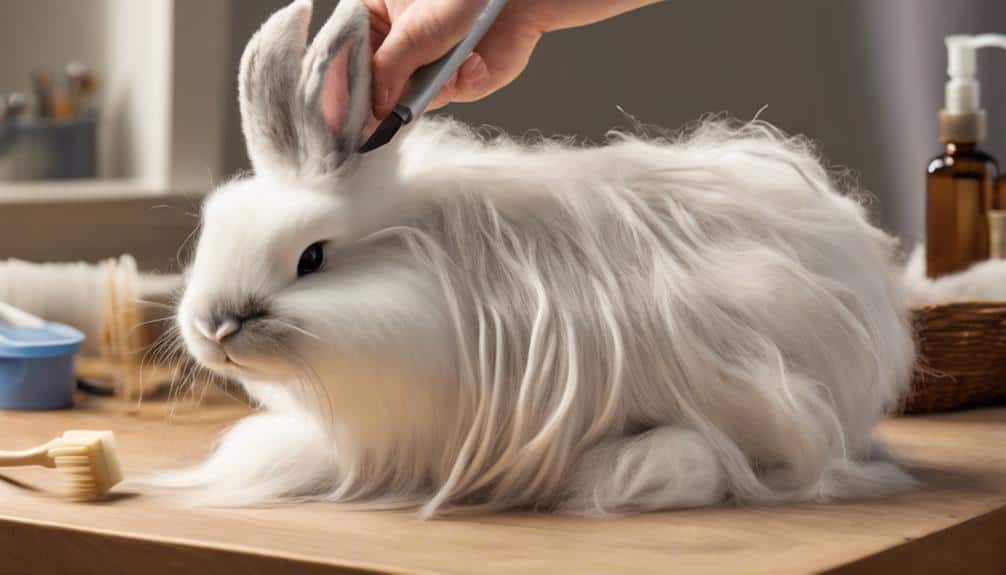
Wondering how to handle matted fur in your bunny without causing discomfort or harm? When dealing with matted fur, it's important to detangle gently using a fur splitter or mat rake. This helps prevent any pulling or pain for your furry friend. For more severe matting concerns, such as large or stubborn mats, shaving or clipping might be necessary. However, it's advisable to seek professional help for this to make sure the process is done safely and effectively. When considering shaving at home, proceed with caution to avoid accidental cuts or harm to your bunny's sensitive skin.
To prevent matting issues in the future, maintain regular grooming practices and uphold proper hygiene for your bunny. This includes brushing your bunny frequently, especially during shedding seasons, to prevent mats from forming. By staying proactive in your grooming routine and addressing any matting promptly, you can help your bunny stay comfortable and healthy.
Special Care for Long-Haired Bunnies
For owners of long-haired bunnies, daily grooming is essential to prevent matting and maintain their fur's health and hygiene. Long-haired rabbits, such as Angora and Lionhead breeds, require special care to keep their fur in top condition.
Here are some key tips for caring for your long-haired bunny:
- Trimming the Fur: Regularly trimming the fur of long-haired rabbits can help manage its length, reducing the chances of matting and making grooming more manageable.
- Brushing in Layers: When grooming long-haired bunnies, make sure to brush in layers to reach the undercoat. This technique helps in maintaining the fur's health and prevents matting issues.
- Hygiene Maintenance: Keeping the belly fur trimmed is vital for reducing matting and maintaining hygiene in long-haired rabbits, especially during shedding seasons. This practice not only keeps your bunny comfortable but also prevents potential health issues.
Frequently Asked Questions
How Do You Brush a Rabbit's Fur?
To properly brush a rabbit's fur, use a soft brush and gently stroke in the direction of hair growth. Start with the back, then move to sides and legs. Pay attention to tricky spots like behind ears.
How Often Should You Brush Your Bunny?
You should brush your bunny's fur according to their needs. Grooming frequency varies, but weekly during shedding seasons and every 2-3 days otherwise can help prevent matting. Use gentle strokes, follow fur direction, and bond during grooming for fur health and care.
Can You Overbrush a Bunny?
You can definitely overbrush a bunny, causing skin irritation and hair damage. Remember, grooming tips include gentle strokes, proper tools, and avoiding mats. Find the balance in rabbit care to prevent tangles and guarantee gentle grooming during shedding season.
How Do You Clean a Rabbit's Hair?
When cleaning a rabbit's hair, remember grooming techniques are important. During shedding season, prevent mats by brushing gently. Care for nails, bathe sparingly, and guarantee coat health with proper brush types and conditioning. Remove tangles and clean ears regularly.
What Should I Avoid When Brushing My Bunny’s Fur to Ensure I’m Doing It Properly?
When brushing your bunny’s fur, there are a few important ways to brush bunny’s fur that you should avoid in order to ensure you are doing it properly. Avoid brushing too forcefully to prevent causing discomfort or injury to your bunny. Also, avoid using harsh or inappropriate grooming tools that could harm their delicate fur.
Conclusion
Now that you've learned the proper way to brush your bunny's fur, remember that grooming isn't just a task, but a way to show love and care for your furry companion.
Just like a gentle breeze through a meadow, your bunny's fur should be soft and free of tangles.
By taking the time to groom them regularly, you aren't only keeping them healthy, but also creating a bond that will last a lifetime.


